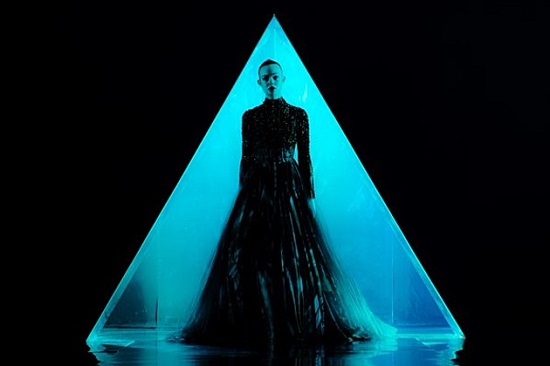Over the course of his last three films, themed use of neon has become director Nicolas Winding Refn’s trademark. Drive‘s flamingo pinks and icepick blues served to give its traditional LA noir setting a novel, battery acid tang, while Only God Forgives‘ more subdued deployment of bruised purples and crimsons provided a perfectly surfaced pool in which to glimpse its portrayal of Oedipal struggle. Appropriately enough, for his latest film The Neon Demon, a cruel and calculated fashion world fantasia, equal parts Elizabeth Bathory and 42nd Street, Refn’s chosen hue is a deep, fresh-from-the-jugular red, in fitting with the film’s atmosphere of simmering jealousy, exoticised danger and opulent blood letting.
It’s a story as old as aspiration itself. A naif – played to engagingly wide-eyed perfection by Elle Fanning – moves to LA from some unspecified backwater in search of fame in the fashion industry, achieving everything she dreams of, only to be pulled into the shadows by her chosen profession’s darker currents – represented in this case by an envious trio of so-last-weeks played with insectoid intensity by Jena Malone, Bella Heathcote and Abbey Lee.
And yet if The Neon Demon is even remotely concerned with being the latest in a long line of a-star-is-born-a-star-is-pawned films it doesn’t show. Indeed, The Neon Demon doesn’t give much indication of being concerned about anything beyond its own immaculate reflection. Slinkily choreographed, bathed in luxurious colours and soundtracked by the kind of thudding electronica that can only be conjured from synthesizers purchased with Hollywood money, the film possesses an air of sharpened vacuousness that lends it a hypnotic tug, but which also frequently pushes it into solipsistic inertia.
Oddly enough, for all of its director’s reputation as a stylist, or indeed its chosen subject matter, much of The Neon Demon is served dry. LA afternoons are bleached out and airless; stilted conversations are conducted against a backdrop of silence, which leaves awkward lines – “Are you food or are you sex?” “Who wants sour milk when you can get fresh meat?” – gaping open like untended wounds. It’s often flat, occasionally boring, but always straight-faced, unwilling to crack a smile or break its pose.
There’s very little sex in this world, and what there is is joyless. The fashion industry is presented as a series of vacuous cabals powered by jealousy and craven hunger. It’s a mean existence dispassionately observed, and this is where the film’s power is located. The Neon Demon feels like Winding Refn pointing the way toward what the true art of our vanity bloated era might look like. A work of cold-eyed self-absorption that manages to linger like the scent of perfume; plot and motivation distant seconds and thirds to its painstakingly maintained ambience of oppressive self regard.
Simultaneously a commentary on our image obsessed culture and a proud product of it – a contradiction you can imagine its director relishing – this attitude does become a problem in narrative terms. If The Neon Demon were to show the strain of reaching for something outside of itself it would make its own beauty redundant. Far better to court boredom than to risk failure. However, the succession of immaculately poised and choreographed scenes eventually becomes deadening. Shorn of the quasi-mythical narratives that propelled Valhalla Rising, Only God Forgives and Drive, The Neon Demon feels essentially pointless – an endless hall of mirrors reflecting corruption and beauty with ultimately little to say about either of them. There’s no resolution or revelation, just a rapidly clotting ambience.
Most of The Neon Demon‘s successes are down to Winding Refn and his cinematographer Natasha Braier’s skills as composers of unforgettable imagery. The ‘Demon Dance’ scene is one of the most pleasingly and immaculately perverse things you’ll see in the cinema all year, and the combinations of light, choreography and music are consistently impeccable. There are few more enjoyable sensations in cinema than seeing Hollywood’s pre-eminent stylist demonstrating why what he does has left an indelible mark extending far beyond his chosen medium. However, it’s notable that The Neon Demon‘s most striking moment occurs when Jesse is confronted by a live wildcat, arched and lithe, baring its fangs in the light from outside her flophouse hotel room. The contrast between the snarlingly, terrifyingly alive and the obsessively poised is something that the film would have benefited from exploring more. It’s an electrifying sight, precisely because it’s the only time during the film that we sense we are being confronted with something that could at any moment break away from its director’s absolute control.
The Neon Demon is in UK cinemas from today


